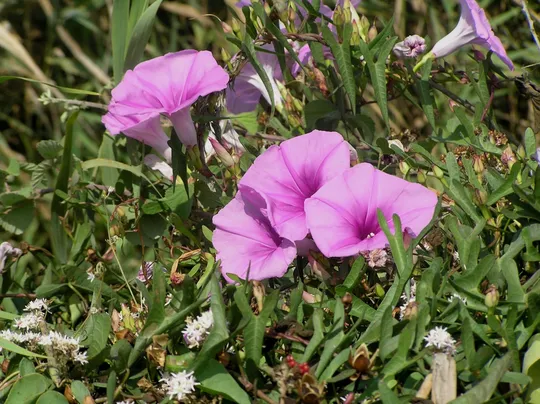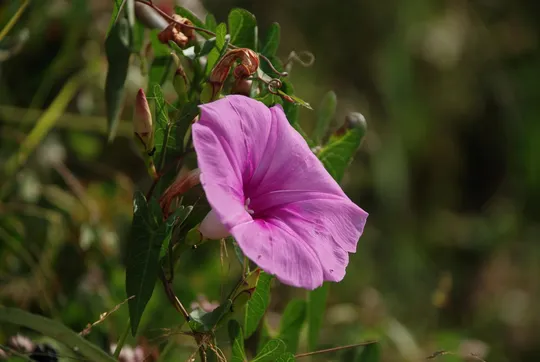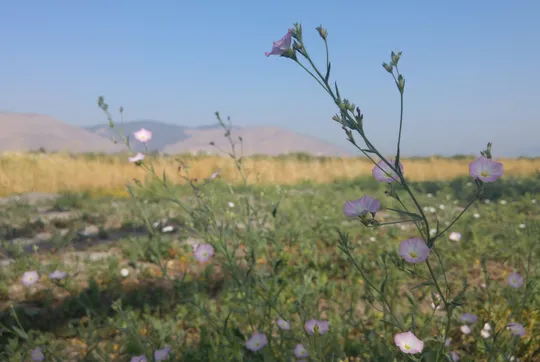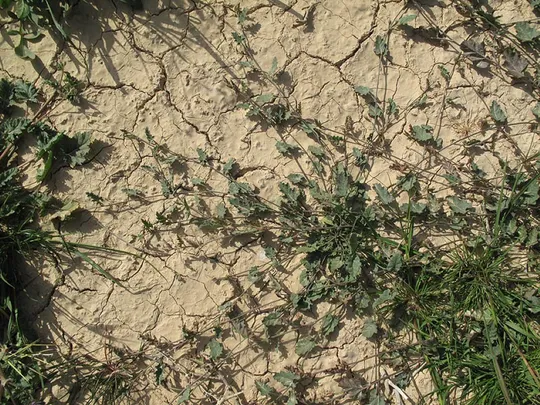Salt-marsh Morning Glory
Ipomoea sagittata


Ipomoea sagittata grows in three regions on Israel's coastal
plain, in a fragmented distribution pattern. In the Acre Valley it is found at four
sites along the Na'aman Stream from Kiryat Bialik to En Namfit and is extinct
in the Kishon. On the Carmel Coast, the plant grows at six sites in the area of
the Dalya Stream-Taninim Stream fishponds. In the Sharon, two sites are
known along the Alexander Stream and I. sagittata is extinct in Wadi
Hadera. A total of 12 sites are known but there may be another site, reaching a
total of 13 sites.
Marshes
and stream banks.
The Convolvulaceae family, to which the genus Ipomoea belongs, includes 85 genera of which five grow in
Israel: Cuscuta, Cressa, Convolvulus, Calystegia
and Ipomoea. Ipomoea differs from Convolvulus in its style that has a spherical stigma, unlike the split stigma
of Convolvulus. The genus Ipomoea has 500 species, found mostly in the
tropics. Apart from I. sagittata, two additional species grow in Israel: I. stolonifera, a prostrate beach plant that spreads
along the ground and has whitish-yellow flowers and I. cairica that has pink flowers and palmate
leaves, found as a hedge climber and is usually feral. Several species of Ipomoea
grow in Israel as edible or
ornamental plants; particularly well known is I. batata whose thickened roots
("sweet potato") are used for food. The sweet potato’s origin is from
tropical America from where it has spread to Southeast Asia and to Polynesia
and is cultivated today all over the world.
•
During the past
decades, there has been no change in the distribution regions, and numbers of Ipomoea sagittata.
However, the species has become extinct from some of sites from which it had
been known in the past, such as the Kishon Swamp and Wadi Hadera.
•
I. sagittata
mostly grows as single plants.
•
The threats to
Israel's wetlands – drying and pollution – threaten I. sagittata
as well as other aquatic plants.
•
The species is
protected in a number of nature reserves: En Namfit, En Afek and Enot Timsah.
•
Other than in
Israel, I.
sagittata is considered "endangered" (EN) according to
the IUCN classification. In the Mediterranean countries, its populations are
declining and on many sites in these countries, it is extinct. It is listed in
the Red Book of Cyprus and classified as “critically endangered" (CR)
according to the IUCN.
Pollution and drainage of wetlands where Ipomoea sagittata
grows should be prevented. The propagation and growth of the species should be
studied and it should be cultivated in gardens as another means of
preservation.
Ipomoea
sagittata grows in the Mediterranean countries and islands:
Spain, the Balearic Islands, Corsica, Italy, Greece, Turkey, Syria, Lebanon,
Israel, Jordan, Cyprus, Tunisia, Algeria and Morocco. It also grows in tropical
America, but its origins are probably Mediterranean. In the southeast United States,
it is a noxious weed.
Ipomoea
sagittata is a
perennial climbing vine that grows on stream banks and in marshes. It is found
at only a small number of sites in three regions of the northern coastal plain.
The plant is highly endangered because of its rarity and because of the great
sensitivity of aquatic habitats to drying and pollution.
Current Occupancy Map
| 1000 squre meter pixel | 5000 squre meter pixel | 10000 squre meter pixel | |
|---|---|---|---|
| number of observations | 0 | 0 | 0 |
| in total pixels | 0 | 0 | 0 |
| Family | Convolvulaceae |
| Classification | On the endangered species list |
| Ecosystem | Mediterranean humid |
| Chorotype | Mediterranean – Tropical America |
| Conservation Site | En Namfit, Dalya Stream |
| Rarity |
1
1
6
|
|---|---|
| Vulnerability |
0
4
4
|
| Attractiveness |
0
3
4
|
| Endemism |
0
0
4
|
| Red number |
1
4.7
10
|
| Peripherality | N |
| IUCN category | DD EW EX LC CR EN VU NT |
| Threat Definition according to the red book | Endangered |
 Based on:
Based on:





